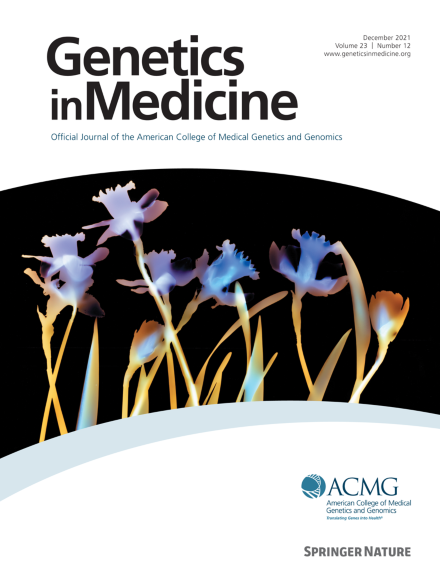COL6A1/2/3外显子3 '端核苷酸的替换诱导外显子跳变,这与vi型胶原相关的肌营养不良和治疗策略有关
IF 6.6
1区 医学
Q1 GENETICS & HEREDITY
引用次数: 0
摘要
目的以近端肌无力和关节挛缩为特征的胶原蛋白vi相关肌营养不良是由COL6A1 ~ COL6A3基因的致病变异引起的。COL6A1外显子最后一个核苷酸的单等位变异最初被归类为错义变异,但作为剪接变异,导致外显子跳变。在这里,我们评估了COL6A1到COL6A3外显子3 '端的单核苷酸变异是否会导致异常剪接。方法从我们的知识库或公共数据库中鉴定出患者的相关变异,并分析其COL6A1至COL6A3肌肉转录本。此外,我们还利用minigene assay和SpliceAI在硅预测中分析了变异对剪接的影响。结果怀疑胶原vi相关表型个体的肌肉转录结果显示外显子跳变(跳变率为12%)。minigene试验和计算机预测实验的结果支持了这些发现。评估了两种治疗方法,前信使RNA剪接纠正或成熟信使RNA基因沉默。其中,利用靶向跳过转录物的短干扰rna进行基因沉默被证明可以有效地恢复含有致病性变异体的细胞中的胶原VI。结论外显子3 '端单核苷酸变异可导致异常剪接,针对此类变异的等位基因特异性基因沉默是一种很有前景的治疗策略。本文章由计算机程序翻译,如有差异,请以英文原文为准。
Substitutions of nucleotides at the 3′ ends of COL6A1/2/3 exons induce exon skipping associated with collagen VI-related muscular dystrophies and therapeutic strategies
Purpose
Collagen VI-related muscular dystrophies, characterized by proximal muscle weakness and joint contractures, are caused by pathogenic variants in the genes, COL6A1 to COL6A3. A monoallelic variant at the last nucleotide of a COL6A1 exon was initially classified as a missense variant but acted as a splicing variant, resulting in exon skipping. Here, we evaluated whether single-nucleotide variants at the 3′-ends of COL6A1 to COL6A3 exons cause aberrant splicing.
Methods
Ten relevant variants were identified in patients from our repository or public databases, and their muscle COL6A1 to COL6A3 transcripts were analyzed. The effects of the variants on splicing were also analyzed by minigene assay and SpliceAI in silico prediction.
Results
Transcripts from muscles of individuals with suspected collagen VI-related phenotypes showed exon skipping (skipping rate >12%). Findings of minigene assay and in silico prediction experiments supported these findings. Two therapeutic approaches, splicing correction of pre-messenger RNA or gene silencing of mature messenger RNA were assessed. Among them, gene silencing using short interfering RNAs targeting the skipped transcripts proved to be effective in restoring collagen VI in cells containing the pathogenic variant.
Conclusion
Single-nucleotide variants at the 3′-ends of exons can lead to aberrant splicing, and allele-specific gene silencing targeting such variants is a promising therapeutic strategy.
求助全文
通过发布文献求助,成功后即可免费获取论文全文。
去求助
来源期刊

Genetics in Medicine
医学-遗传学
CiteScore
15.20
自引率
6.80%
发文量
857
审稿时长
1.3 weeks
期刊介绍:
Genetics in Medicine (GIM) is the official journal of the American College of Medical Genetics and Genomics. The journal''s mission is to enhance the knowledge, understanding, and practice of medical genetics and genomics through publications in clinical and laboratory genetics and genomics, including ethical, legal, and social issues as well as public health.
GIM encourages research that combats racism, includes diverse populations and is written by authors from diverse and underrepresented backgrounds.
 求助内容:
求助内容: 应助结果提醒方式:
应助结果提醒方式:


